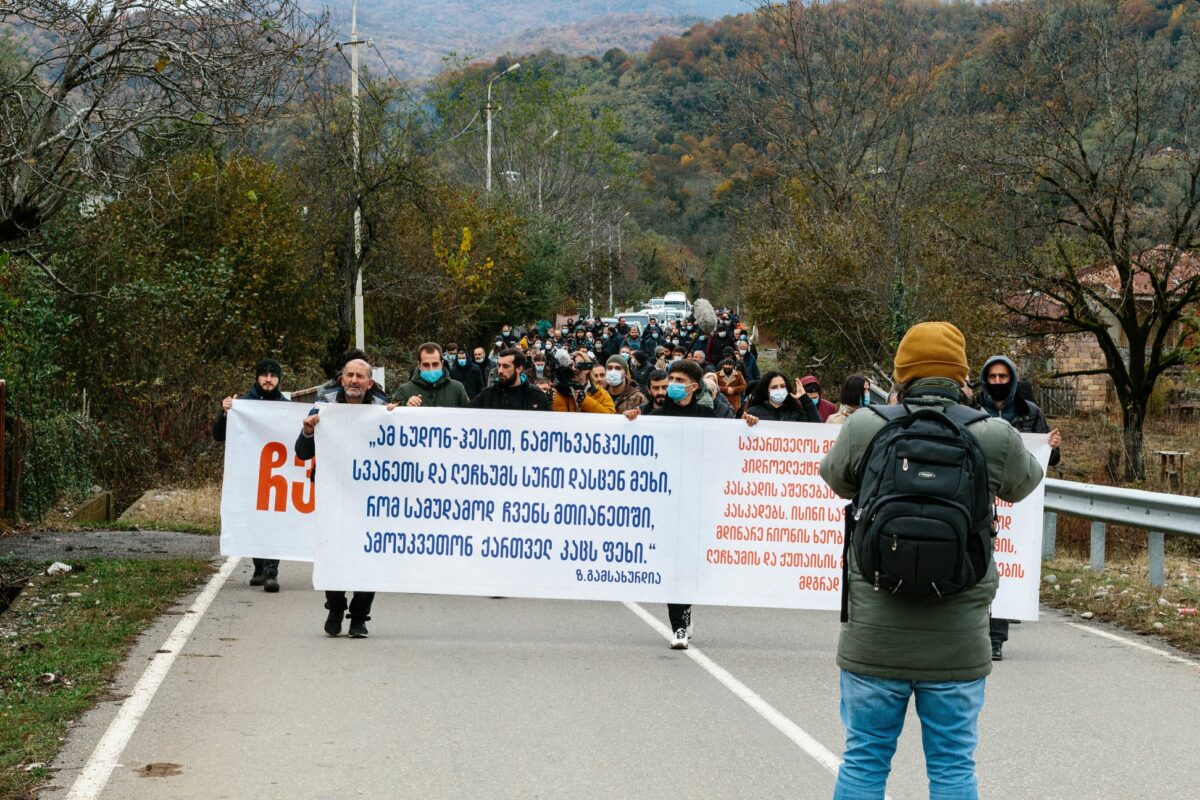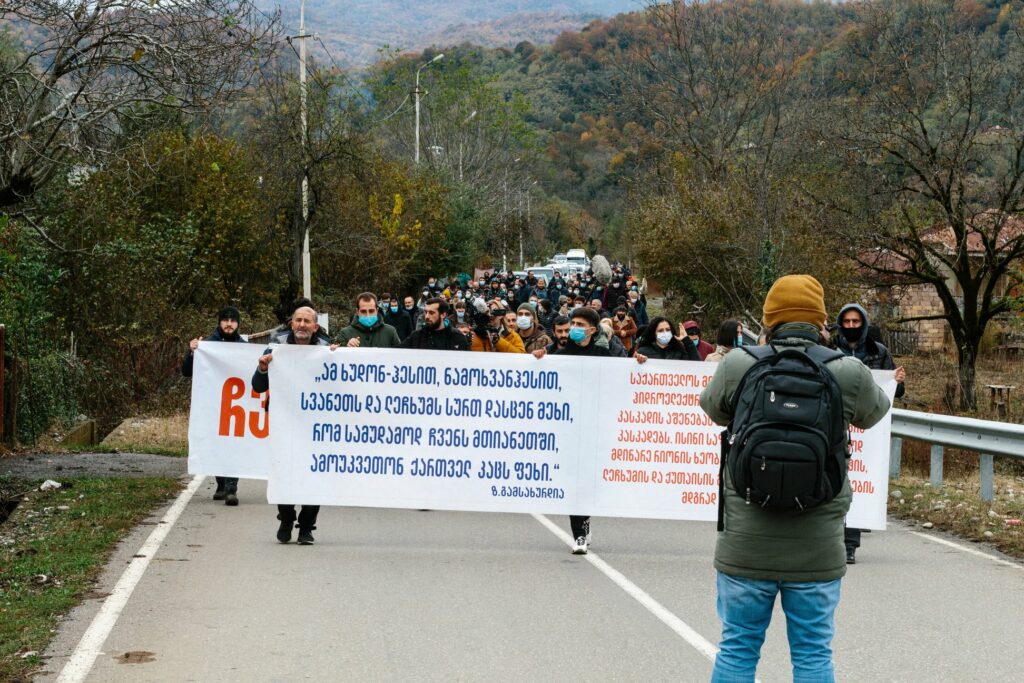
“When it’s so many of us here together, we can afford to say that we don’t need a bloodshed or throwing stones to win this fight. We should all get used to the fact that our fight is long-lasting, it cannot be resolved quickly. The government should know that we will win this war with our spirit, peace, and our unity”. Stated Varlam Goletiani, a young leader of anti-dam movement from one of the mountainous regions of Georgia on a massive protest rally in the second largest city of Georgia, Kutaisi on 28thof February, 2018. The speech might sound generic, but in what follows, I will try to explicate why I see it as an expression of an admirable political sensibility.
Before I tell the story of the fight against “Namakhvani hpp”, one of the largest hydro electric power plant (from now on, hpp) projects in Georgia, let me explain where I speak from and why I speak. For one, I speak to myself, to recall and reconstruct the dramaturgy of this fight, as the fight evolves continuously and I feel the need of retaining contact with the emotions of the previous day, simply to evaluate the weight of this constant change. I speak from the experience of been part of the small informal Tbilisi-based initiative called “Fair Energy Initiative”, one mostly aimed at providing further support to the group of anti-dam protesters from the Rioni valley[1], people that we now know as the “guardians of Rioni valley”[2]. Second, I speak to my non-Georgian speaking friends and comrades, as there are few updates in international media about this fight and I feel the urge to share what I know about it. As far as I’m aware, international media has been covering Georgian politics quite a bit in the past few past days, but predominantly to talk of a surreal rivalry between the two main, similarly recklessly neoliberal, political powers and the political deadlock they have created. The international coverage used delusional frames of interpretation, focusing on Georgia’s sliding towards Russia, or (even better!) towards the Soviet Union. Yet, in the meantime, something truly interesting is also taking place. I don’t have any well-cooked arguments, let alone theorization around this. Rather, I have a feeling that for the political reality of Georgia (and perhaps in the future for also for other peripheral countries) this is a very significant fight. I will try to show why.
My hunch so far is that this fight is fascinating for its consistent build-up of mobilisation efforts, and for bringing up somewhat unprecedented openings of a problem articulation in Georgian politics. Here I think three things are key. For one, this movement already created a unique precedent of impressive mass mobilisation, finding support from various regions of Georgia (and a massive support from migrants), in the absence of a political party involvement, and importantly, in a peripheral context. Second, it has demonstrated the severe detachment of existing political powers (and the subordinated media) from the concerns of their supposed electorate. Finally, it has made visible the pains and ills of an open-door, foreign capital-driven, developmental politics of a peripheral country (in relation to Europe, Turkey and Russia). This last aspect is the trickiest, as the discourse is not quite crystallised yet. The situation challenges liberal supporters of the fight who usually blame such troubles on corruption and Georgia’s relative ‘backwardness’ in relation to Europe. The story also lands itself to a nationalist articulation of the pain. Yet the movement itself has not collapsed into one or the other discourse so far, opening a possibility for alternative articulations of the problem’s diagnoses. Most importantly, I believe that the persistent mobilisation tactics of the Rioni valley guardians, the moral and ethical positions they took, is predominantly responsible for opening this new space of articulating political contentions.
An invisible protest: social and environmental concerns
I, and probably many other current supporters, learned of the existence of the protest in 2020. However, the community in the valley has been fighting against the construction of large hydroelectric power plants (hpps) for a few decades now. The idea of constructing an hpp was discarded during Soviet times (in 1988) because of locals’ resistance, and further studies indicating project’s unsustainability. Much like in many Central Asian states, where the achievements of the environmental movements of Soviet times are currently being reversed and Soviet energy and infrastructure projects are revived by foreign (often Chinese) investors, by the late 2000s the Georgian government revived a few large hpp projects of Soviet origins and sought international investors to finance the projects. The resistance in Rioni valley is the latest, preceded by mobilisations primarily in Svanetia but also other mountainous regions of Georgia. Therefore, one can see the guardians of Rioni valley as part of a broader movement, taking roots in Soviet times, reincarnated in various localised struggles in different mountainous regions in the past decade, not seamlessly connected, but still accumulating knowledge and experience, as well as standing in support of each other.
These resistances, and consequent withdrawal of EBRD and EIB[3]from some of the larger projects’ financing, led to certain projects plans being discarded or stalled. Yet, the hpp offensive pursued by successive Georgian governments in the past decade also resulted in construction of many and the planning of dozens of other problematic hpp projects. The so called “Namokhvani cascade” is one of the largest such projects, first revived in the early 2010s, and coming closer to implementation since 2015. Protest and mobilisation accompanied each revival and development stage of project planning. Publics beyond the affected populations and a relatively narrow circle of environmentalists, learned of the project in summer 2020, when protests were staged against this and yet another hpp cascade project on the upper part of the valley. As the company kicked off the construction works framed as ‘preparatory’ works, a small group of protesters put up tents and occupied the site to physically stall the construction process.
Besides the ongoing neglect of mainstream media, a few aspects truly complicated the situation of protesters. They fight in one of the poorest and most depopulated regions of Georgia against a large-scale infrastructure project, one framed by the government as a major developmental opportunity for the region and for the energy-security of the whole country. Additionally, long before the project was approved, the company started buying off the land and property of local inhabitants, making this small group of protesters look like a stubborn minority of families that refused to sell their plots of land.
It was in late October, in light of police brutality on protesters, that the previously invisible, decades-long struggle of the Rioni valley population started attracting more attention. By then, various experts and environmental organisations such as Green Alternative had already revealed and documented [1] a range of grave shortcomings in environmental impact assessments as well as [2] violations of national and transnational norms on engaging affected populations in decision making. By then the local community predominantly emphasized serious environmental risks (one of those being potential flooding of most of Western Georgia’s lowlands), and the unwillingness to leave behind their livelihoods. After the first police raid, they staged a few larger protests and simultaneously continued occupying the construction site. Several other smaller non-formalised initiatives and NGOs started or strengthened supportive activities, mostly through Facebook based information campaigns, but at points also staging small-scale protests in the capital, appealing to the government and the parliament to open-up public debates on this secretive project deal.
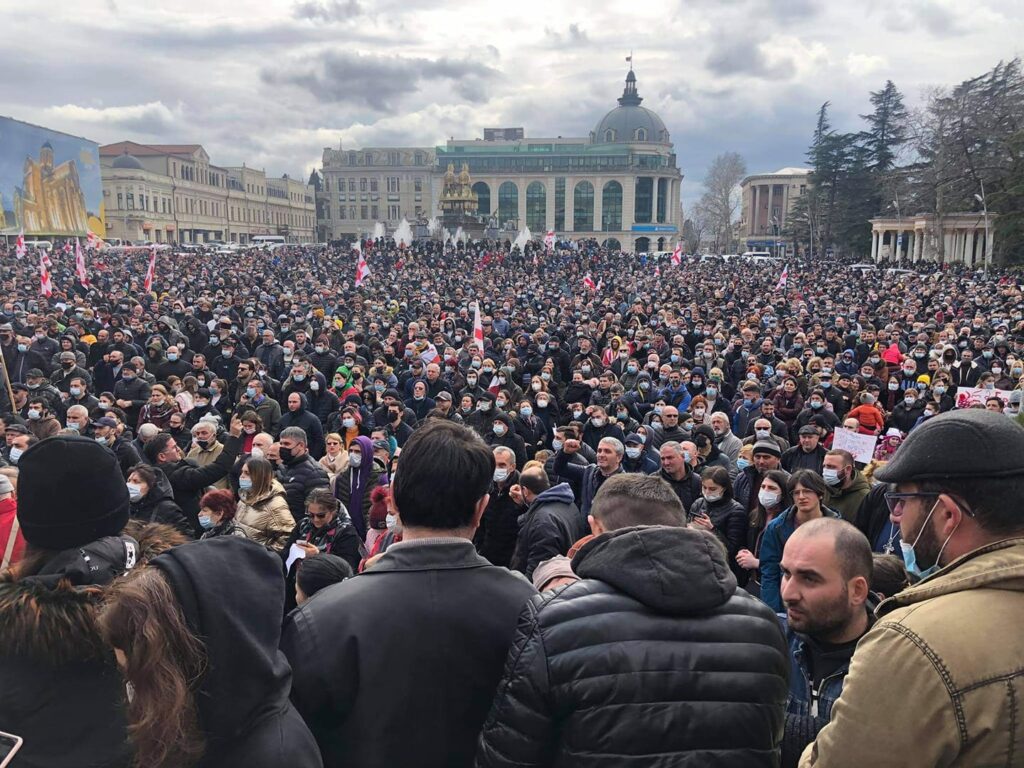
The government responded initially with an aggressive informational campaign. A number of government affiliated TV channels started using a well-rehearsed tool of demonization against similar peripheral movements and its supporters, portraying them/us as enemies of energy-independence, progress and development, as backwards and uneducated, and of course, as ‘Russian spies’. In early January, the government also utilised a moment of declaring the spike in electricity prices to blame it on the anti-hpp movement.
Yet the local movement was also discursively becoming stronger, and was asking more and more critical questions about the “Namakhvani hpp”, and about energy politics more broadly. They questioned why 10% of used electricity is spent on (hardly taxed) bitcoin mining, how come the state insists that 100 hpps have to be built without having any long or medium plans of energy sector development, why do contracts with private construction companies remain classified. In other words, the movement started moving beyond local injustices and carefully but consistently, questioning the energy sector politics per-se. The guardians, as well as the rest of us, also cited a World Bank study from 2018, indicating that this project would only lead to increased electricity prices and create a considerable fiscal burden for the national budget.
A second brutal police raid at the protest site in the Rioni valley, on January 30th, turned out to be a game changer. It set off a next stage of repressions, revealed further crucial details about the hpp project, and triggered further major shifts in the movement’s discourses. The government insisted they had to live up to their duty of enabling the company to pursue construction works. Police forces forcefully demolished protesters’ tents removed the cross that the movement had put up as a symbol of their struggle and importantly declared that the land protesters occupied was in the ownership of the company. By that point, the guardians of Rioni valley had slowly, but surely built-up support. They had (with support of NGOs like Green Alternative and the Young Georgian Lawyers association) already made a court appeal. They also had pursued a modest but extremely consistent Facebook campaign, posting pictures from their tents every evening, and sharing live videos about the evolution of their daily struggle.
Rescaling the framing of injustice and the role of peaceful struggle
After the second police raid, the guardians of Rioni Valley and some smaller and relatively marginal media and civic supporters contributed to revealing crucial details about the “Namakhvani” cascade. Perhaps the most important was that the land purchase agreements became public, revealing that the company had purchased or took on a 99 years long lease over 600 hectares of land already in summer 2019, that is before impact assessments were submitted by the company and before construction permits were approved by the state. This revelation triggered a broader public outcry against secretive land privatisation. It also altered the nature of the conflict between those local groups that protest against the hpp project and the ones who had already sold their lands. It became possible to articulate that individuals had to make a decision of selling their property without knowing what this hpp project really entailed.
Soon after, one of regional media platforms managed to also make public big parts of the contract between the Georgian state and Turkish company “Enka Renewables”. The contract itself is a masterpiece of a peripheral country subjecting itself, or rather local political elites subjecting public resources, to the interests of international capital. It provides endless guarantees to the company: selling hundreds of hectares of forests and arable lends for literally no money, committing to purchasing electricity from the company at a fixed price (in some seasons higher then the cost of imported electricity) for 15 years, paying for this electricity even if the company for various reasons fails to produce the named amount of electricity, committing to the provision of publicly funded (through EBRD sanctioned loans) infrastructure for export of this electricity, and a range of other absurd commitments in exchange for promised 800 mil USD investment.
And lastly, it was revealed that the construction permits had lost validity in September 2020, as the company failed to deliver required studies. That is, since January 30th, for a month, the state was mobilising police forces – as if those were private security forces of the company – to protect an illegal construction process. The circulation of these newly publicised realities about the “Namakhvani hpp” protest dramatically increased popular support for the guardians. In live streamed videos, we watched how their access to their homes was restricted by the police when the company was exploding some of key sites of their struggle; we watched how the Turkish manager of the company took time to step outside of his SUV, tease and scream at the protesters, we watched how the guardians were invited for a parliamentary committee hearing, to be told that the parliament had no resources to process the case. Obviously, many of us got angry.
Rescaling the framing of injustice and the role of peaceful struggle
In the meantime, the guardians started reframing the scale and importance of the project deal with an enviable eloquence. From a protest that stood for the interests of the local population, or warned against broader environmental implications, it grew into a protest that articulated deep injustices on a national scale. If their concerns were previously downplayed vis-à-vis the economic benefits and the promise of energy-independence, now the movement could articulate that there were no economic benefits, but rather a robbery, or to say it in Hildyard’s words, a ‘licenced larceny’ (Hildyard 2016), of impressive proportions.
Let me come back to where we started from: the insistence (so far) on peaceful ways of protest. The speech by Rioni valley guardian Varlam Goletiani, cited in the opening paragraph of this article emphasizing that the war had to be won slowly and peacefully, was made in response to a speaker before him, one of the veterans of anti-dam movement from Svanetia. She in her turn had argued that what the movement now needed was to show strength and go for violent attacks on the company. She even mentioned that the only times when anti-dam movements found success was the times when violence and physical clashes were involved. And she was right, it is actually true that the only time when hpp projects failed in Georgia (in the Svanetia and Pankisi regions) was when violence erupted. I do not exactly know why other struggles had to resort to violence. I could imagine that it was because the state simply refused to negotiate with them on any other terms. I also don’t know how come the protesters in Rioni valley managed to avoid violent escalations of the conflict so far, and let me note, it is a conscious strategy taking excessive amount of efforts on behalf of the guardians to pace supporters’ anger. It might be that it’s a cumulative effect of previous struggles that contributed to diversification of tactics in this case, or unique inner organisational capacities. Perhaps it’s also the fact that the guardians face conflicts with the rest of the local population and could not afford to become combative. Importantly, there is no guarantee that violence will not follow.
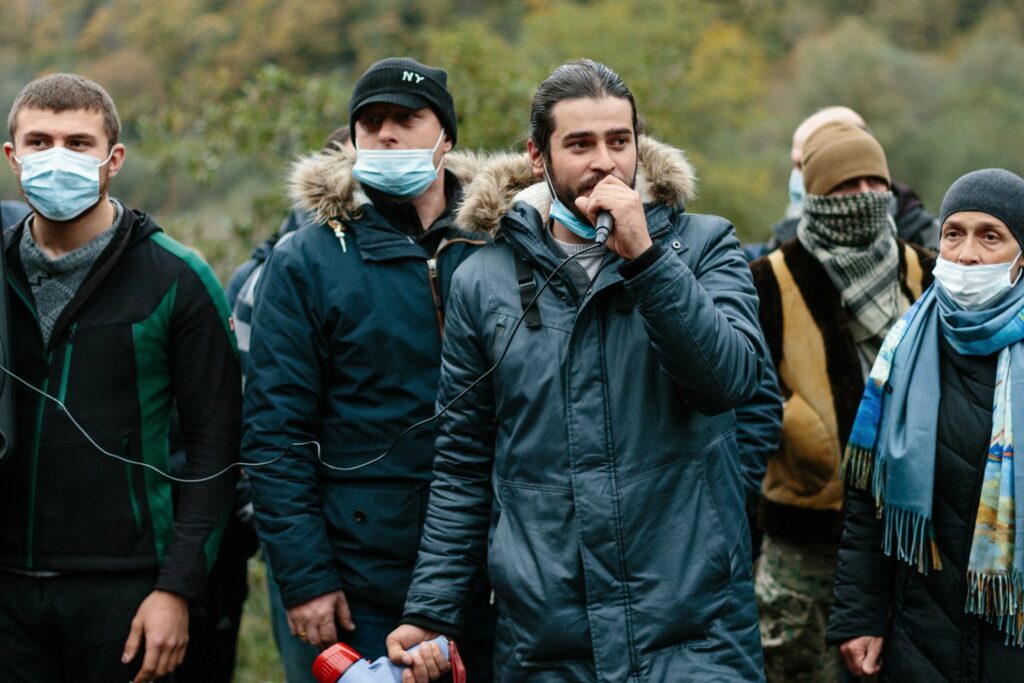
To be frank on this: neither I personally, nor the initiative I’m affiliated with, and as a matter of a fact, nor the guardians themselves have an ideological stance against violence. So far however, I am simply grateful for the tactics that the guardians of Rioni valley chose, as it contributed to an unprecedented scale of politicisation of the struggle and created a rare precedent of questioning privatisation and foreign-capital driven development.[4]The Rioni valley protesters can indeed say that they have used all available non-violent means of protest, have appealed to courts, have talked to media, have reported to the parliament, have stayed in tents for four moths, have mobilised regular protest rallies in the valley, in Kutaisi, in the capital city, Tbilisi. Through this extremely painstaking process they have managed to gain the power, or as the guardians would have it ‘moral superiority’, that allowed them to unpack and reveal the details of the “Namakhvani hpp”, and importantly to deliver these details bit by bit to engaged publics. It also led them to staging the massive protest of 28thof February in Kutaisi, after which the company has suspended the construction process. They have given an ultimatum to the state to pull out the private company from the valley, or they would be picketing Kutaisi by March 14th. Supporters of the struggle have grown in numbers, with more people joining the guardians’ permanent protest in tents, and the media attention to their struggle has increased substantially. Importantly, on Friday, March 5th, two state ministers have visited the guardians at the cite of their protest in the Rioni Valley, and on March 9tha discussion took place in Parliament. Both events confirmed that the government reduced the complex conflict to a problem of insufficient communication, intends to slow down the protest, and insists that the construction process should and will resume. The guardians state that the planned protest on March 14th will nevertheless take place and the permanent protest will also continue as long as the company “Enka” stays in the valley.
Further politicisation and importantly, interpretation of this struggle are yet to be seen. Leftist circles in the post-socialist east have long been concerned with the incapacity of environmental struggles in articulating openly anti-capitalist claims in the region. Here as well the situation is tricky. It is clear that a more nationalist leaning interpretations of the struggle – the need to protect the land from a historical enemy, Turkey – resonates with some segment of supporters. It is also clear that the protesters don’t quite talk in the language that the small group of Georgian leftist would like. They don’t exactly call out imperialism and coloniality, discuss class struggle, capitalist accumulation, uneven development or peripherality. Yet they have achieved a far greater traction in criticizing the capitalist developmental path in Georgia than any other movement before it. In relation to the nationalist sentiments, the guardians and also the supporting initiatives and NGOs have taken a clear stance in stating that just because in this particular case they protest against a Turkish company, it does not imply concerns with Turkey per se, but rather with privatisation of the entire valley at the hands of a private company. In relation to leftists’ concerns, I think the latter should truly be glad that this movement has moved far beyond the usual blaming of corruption, bad mentality and lack of Europeanness, instead focusing on unfairness of delivering public natural and economic resources in the hands of a private company. It has unmasked the discourse of progress, development, economic benefit, and the charm of large investments to be direct and unapologetic robbery.
Meantime the fight against “Namakhvani hpp” continues. Considering how strongly the government insists they will not reconsider the project deal, the protest will probably continue for a while. If you would consider supporting this fight, visit the fundraising campaign here.
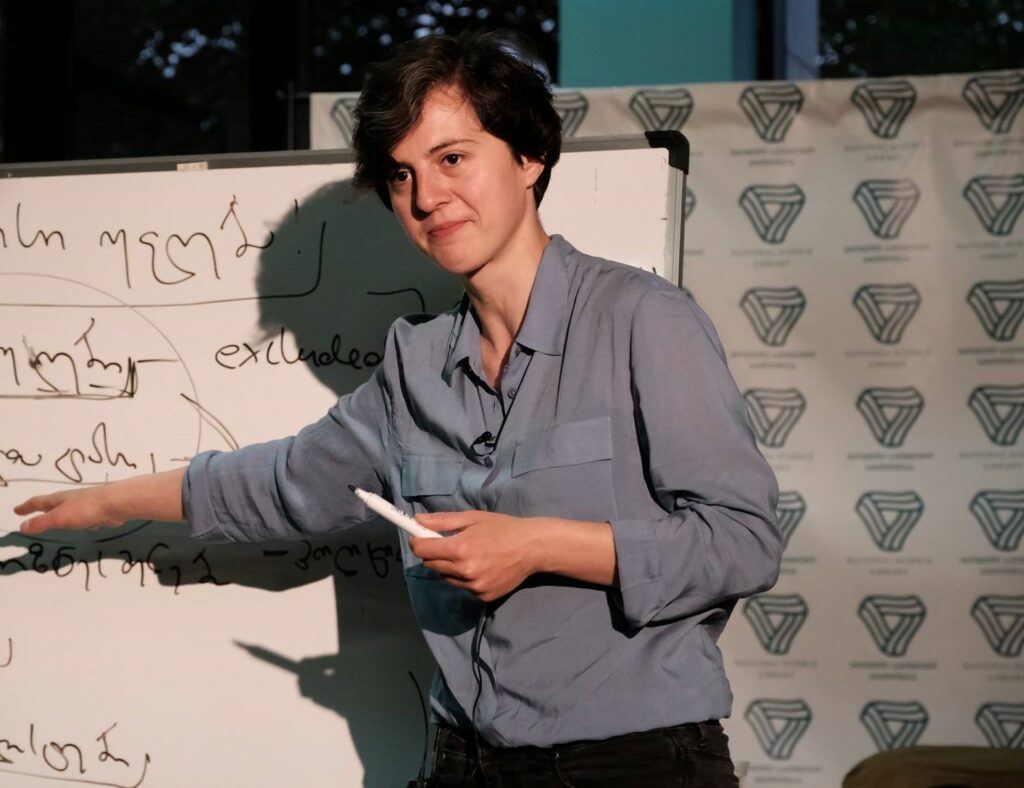
Lela Rekhviashvili is a post-doctoral researcher at Leibniz Institute for Regional Geography, Leipzig. Her research interests include the political economy of transition, informal economic practices, social movements, everyday resistance, and urban mobility. Her academic publications discuss post-soviet shared taxies in a comparative perspective with ride-sharing and informal transport, the role of everyday resistance in production of public space, and the impact of institutional change, particularly of marketization policies on informal economic practices.
[1]Here is a documentary film by Elene Asatiani, with English subtitles about anti-dam protesters: https://www.youtube.com/watch?v=BXakzKX7IBM&t=426s&ab_channel=JAMnews
[2]The guardians of the Rioni Valley represent a relatively small group of protesters living in or coming from the affected villages in Tsageri and Tskaltubo districts in Western Georgia. The most visible participants of the group are persons and families from that would be displaced if the hpp would be built. It should be noted, that women have played a particularly active role in the group formation and sustenance, accompanied by a young man, Varlam Goletiani, who has become the most visible face and speaker on the behalf of the group. This group of families refuse to sell their property and some face a threat of expropriation. They are predominantly engaged in household agriculture, and sometimes in small scale tourism and wine-making. The core group of 10-20 persons were initially supported by inhabitants of neighboring villages, taking shifts in tents, for more that 130 days now. Currently the volume of supporters has increases substantially, with groups and individuals coming to the Rioni valley to take turns in tents from across Georgia.
[3]European Bank for Reconstruction and Development and European Investment Bank – both major players in financing large scale infrastructures in Europe’s peripheries and beyond. EBRD is particularly well known for financing large HPPs as part of supporting green energy infrastructure development.
[4]A somewhat similar process already took place a few years ago, when another enslaving project deal regarding “Neskra hpp” project in Svanetia became public, and while mobilisation was also strong, the public visibility and support dimension was not quite comparable.

